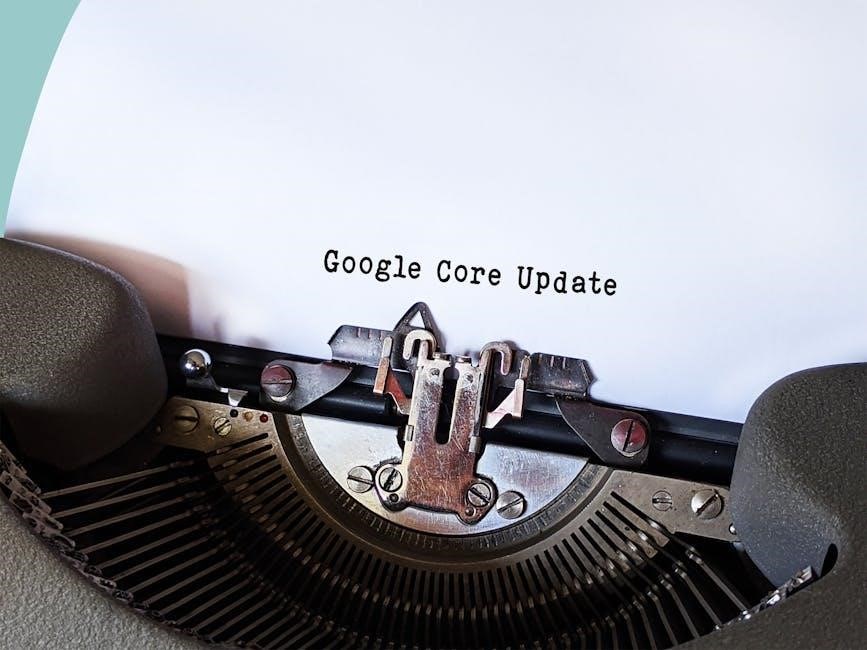This project aims to develop a dynamic web-based news portal, providing up-to-date news to global audiences. It focuses on user-friendly navigation, responsive design, and essential features like news categorization, search functionality, and user authentication. The system is designed to overcome traditional manual news management challenges, offering a robust platform for news dissemination and interaction.
1.1 Overview of the Project
The News Website System Project involves developing a web-based platform for publishing and managing news content. It aims to provide a user-friendly interface for readers to access categorized news, while allowing administrators to manage content efficiently. The system integrates essential features like news categorization, user registration, and comment management, ensuring a seamless experience.
1.2 Purpose and Objectives
The purpose of the News Website System Project is to create a web-based platform for efficient news dissemination. Its primary objectives include providing up-to-date news, ensuring user accessibility, and enabling easy content management. The system aims to overcome traditional manual news management challenges and offer a robust, interactive platform for both readers and administrators.
1.3 Scope of the Project
The project focuses on developing a web-based news portal with core functionalities like news categorization, search, and user management. It includes front-end design, back-end development, and database integration using tools like PHP and MySQL. The scope is limited to essential features, ensuring a user-friendly and responsive platform for news dissemination and interaction.

Technical Requirements and Specifications
The project requires PHP, MySQL, and a web server for functionality. Hardware includes a server with sufficient storage and processing power. Tools like Apache and SQL Server are essential for seamless operation and database management.
2.1 Software Requirements Specification (SRS)
The SRS outlines the software needs, including PHP for backend development, MySQL for database management, and a web server like Apache. Additional tools may include CMS platforms for content management and SQL Server for advanced database operations, ensuring a robust and scalable news portal system.
2.2 Hardware Requirements
The system requires a web server with a minimum of 4GB RAM, a dual-core processor (2.4GHz or higher), and 50GB storage. A reliable network connection with a bandwidth of 100Mbps is essential for smooth operation. Additionally, client-side devices should have modern web browsers and internet access for optimal performance.
2.3 Tools and Technologies Used

System Architecture and Design
The system follows a three-tier architecture, comprising presentation, application, and data layers. This design ensures scalability, flexibility, and separation of concerns, enabling efficient management of news content and user interactions.
3.1 Frontend Design
3.2 Backend Development
The backend is developed using PHP and MySQL, ensuring efficient data management and retrieval. It integrates SQL Server for relational database operations, supporting complex queries and transactions. Robust security measures, including data encryption and access control, are implemented to protect user information and ensure a secure backend environment for the news portal system.
3.3 Database Design
The database design follows a relational model, using SQL Server for efficient data storage and retrieval. Key entities include News, Users, and Comments, with relationships defined to maintain data integrity. The design incorporates normalization to reduce redundancy and improve scalability, ensuring the system can handle large volumes of news and user interactions effectively.

User Interface and User Experience (UI/UX)
The UI/UX design focuses on creating an intuitive and visually appealing interface, ensuring seamless navigation and accessibility. It prioritizes responsiveness, making the portal accessible across devices, enhancing user satisfaction and engagement through a clean, modern layout.
4.1 User-Friendly Navigation
The navigation system is designed for simplicity, with clear menus and intuitive pathways. Users can easily access news categories, search options, and other features. The system employs breadcrumbs, dropdown menus, and a consistent layout to enhance accessibility and reduce cognitive load, ensuring a smooth user experience across all devices.
4.2 Responsive Design
The portal incorporates responsive design to ensure seamless functionality across devices. Using CSS frameworks and media queries, the layout adapts to various screen sizes, providing an optimal viewing experience for desktops, tablets, and mobile devices. This ensures that all users can access and navigate the news portal with ease and convenience.
4.3 Accessibility Features

Core Functionalities of the News Portal
The portal offers news categorization, search options, user registration, and login features. A comment management system allows user interactions, enhancing engagement and community building effectively online.
5.1 News Categories and Tags
The system organizes news into categories like sports, entertainment, and business. Tags enable specific content filtering, improving user navigation and content discovery. This structure ensures easy access to relevant news, enhancing user experience and efficiency in finding desired information quickly and accurately. Categories and tags are customizable by administrators to meet user needs. Additionally, the system allows for the creation of subcategories, further refining content organization. This feature is essential for managing large volumes of news content, ensuring that users can effortlessly locate articles of interest. The implementation of categories and tags also supports SEO optimization, making the portal more search engine friendly. Overall, this functionality streamlines content management and improves user engagement, making the news portal highly functional and user-centric. The ability to assign multiple tags to a single article ensures that content is easily discoverable across various related topics, enhancing the overall usability of the platform. Administrators can also analyze category and tag performance to refine content strategy, ensuring the portal remains relevant and responsive to user preferences. By providing a structured yet flexible system for organizing news, categories and tags play a vital role in the success of the news portal, both in terms of user satisfaction and operational efficiency. This feature is a cornerstone of modern news websites, enabling effective content organization and user-friendly navigation. The integration of categories and tags is designed to scale with the growth of the portal, accommodating an increasing volume of news articles without compromising accessibility. Furthermore, the system’s ability to support hierarchical categorization allows for precise content organization, ensuring that users can drill down into specific topics with ease. This level of granularity in content organization not only enhances user experience but also aids in content administration, making it easier for editors to manage and update news items. The combination of categories and tags creates a robust content management framework, essential for maintaining a dynamic and responsive news portal. This feature is particularly beneficial for users who seek specific types of news, as it allows them to quickly find relevant content without sifting through unrelated articles. In summary, the implementation of news categories and tags is a critical component of the news portal’s design, contributing significantly to its functionality, usability, and overall effectiveness in delivering news to its audience. The system’s ability to organize and present news content in a structured and accessible manner is a key factor in its success, making it an indispensable feature for both users and administrators alike.
5.2 Search and Filter Options
The system includes an advanced search bar and filters, enabling users to find news by keywords, categories, dates, or tags. Filters allow narrowing results by relevance, date, or popularity, enhancing user experience. Additionally, the portal supports sorting options, such as newest or most-read articles, ensuring quick access to desired content efficiently. The search functionality is optimized for speed and accuracy, providing instant results as users type; Moreover, the system incorporates full-text search capabilities, enabling users to find specific content within news articles. These features collectively improve navigation and content discovery, making the portal user-friendly and accessible. The search and filter options are designed to cater to diverse user preferences, ensuring a seamless and intuitive experience. By providing multiple ways to locate news, the system enhances user engagement and satisfaction, making it easier for visitors to find relevant information quickly. This functionality is essential for maintaining a competitive edge in the digital news landscape, where users expect fast and accurate search results. The integration of search and filter options is a key component of the portal’s success, driving user retention and overall platform effectiveness. The system’s search algorithm is regularly updated to ensure optimal performance and relevance of results, further enhancing user experience. Overall, these features are critical in delivering a robust and user-centric news portal that meets the demands of modern audiences. By prioritizing search and filter capabilities, the system ensures that users can effortlessly locate the news they need, fostering a positive and productive interaction with the platform. This focus on accessibility and usability underscores the portal’s commitment to providing a superior user experience, setting it apart from competitors in the news industry. The seamless integration of search and filter options is a testament to the system’s design philosophy, which emphasizes functionality, efficiency, and user satisfaction. As the portal continues to evolve, these features will remain central to its mission of delivering high-quality news content to a global audience. The ability to quickly and accurately find relevant news is a cornerstone of the user experience, and the system’s search and filter options are designed to meet this need with precision and reliability. By continuously refining these features, the portal ensures that it remains a trusted and preferred source of news for its users; The combination of intuitive search and advanced filtering creates a powerful tool for users, enabling them to navigate the vast array of news content with ease and confidence. This approach not only enhances user satisfaction but also drives repeat visits and long-term engagement with the platform. In summary, the search and filter options are vital components of the news portal, providing users with the tools they need to find and access news content efficiently and effectively. The system’s commitment to delivering a superior search experience is evident in its design and functionality, making it an indispensable feature for modern news consumption. By leveraging cutting-edge technology and user-centric design principles, the portal ensures that its search and filter options remain at the forefront of user interaction, driving success and growth in the competitive digital news market. The system’s ability to adapt to user behavior and preferences further enhances its search capabilities, ensuring that the portal remains responsive and relevant in an ever-changing media landscape. This dynamic approach to search and filtering is a key factor in the portal’s ability to attract and retain a loyal user base, solidifying its position as a leading news destination. The integration of search and filter options is not just a functional aspect but a strategic initiative to enhance user engagement and drive the portal’s long-term success. By prioritizing these features, the system demonstrates its commitment to delivering a world-class news experience that meets the evolving needs of its audience. The result is a news portal that is both functional and user-friendly, providing a seamless experience that keeps users coming back for more. The search and filter options are a testament to the system’s dedication to innovation and user satisfaction, ensuring that it remains a leader in the digital news industry for years to come.
5.3 User Registration and Login
The system allows users to create accounts through a registration process, providing personal details and credentials. A secure login feature ensures authenticated access to personalized services. Users can reset passwords and manage profiles, enhancing security and user experience. The portal supports multiple authentication methods, ensuring flexibility and convenience for its audience.
5.4 Comment Management System
The system enables users to post comments on news articles, fostering engagement. It includes features for replying to comments, reporting inappropriate content, and moderating discussions. Administrators can manage comments, ensuring a respectful and relevant conversation environment. This feature enhances user interaction and community building while maintaining content quality and user accountability.
Database Management System
The system uses a relational database to store news, user, and comment data efficiently. It ensures data integrity, scalability, and security, leveraging SQL Server for robust management.
6.1 Relational Database Design
A relational database management system is used to store and manage news, user, and comment data. The design includes tables for news articles, users, categories, and comments, with relationships defined using foreign keys. Normalization ensures data consistency and reduces redundancy, while entity-relationship diagrams (ERDs) provide a clear visual representation of the database structure and relationships.
6.2 SQL Server Implementation
The system utilizes Microsoft SQL Server for efficient data management. It employs SQL Server Express for cost-effective and scalable solutions. The database supports high performance, advanced security features, and reliable backup options for data recovery, ensuring robust and secure data handling capabilities.
6.3 Data Security Measures
The system implements robust data security measures, including encryption for sensitive information and secure authentication protocols. Access control ensures only authorized users can modify data, while regular audits and backups protect against breaches. These measures safeguard user data and maintain system integrity, ensuring a secure environment for news dissemination and user interactions.
Testing and Quality Assurance
Testing ensures the system’s reliability and functionality. It includes unit testing for individual components, integration testing for interactions, and user acceptance testing (UAT) to validate user requirements effectively.
7.1 Unit Testing
Unit testing involves verifying individual components of the news portal, such as user authentication, news retrieval, and comment submission. It ensures each module functions correctly before integration, reducing bugs and improving system reliability. Automated testing frameworks are used to validate code functionality, ensuring robustness and scalability for the news website system.
7.2 Integration Testing
Integration testing ensures seamless interaction between the news portal’s components, such as frontend, backend, and database. It validates data flow and functionality across modules, identifying interface issues. Automated tools are used to test the system’s performance and coherence, ensuring all parts work together flawlessly to deliver a smooth user experience.
7.3 User Acceptance Testing (UAT)
UAT validates the news portal’s readiness for launch by testing real-world scenarios; It involves end-users and stakeholders to ensure the system meets functional and non-functional requirements. Feedback is gathered to make final adjustments, ensuring the portal aligns with user expectations and industry standards before deployment.
